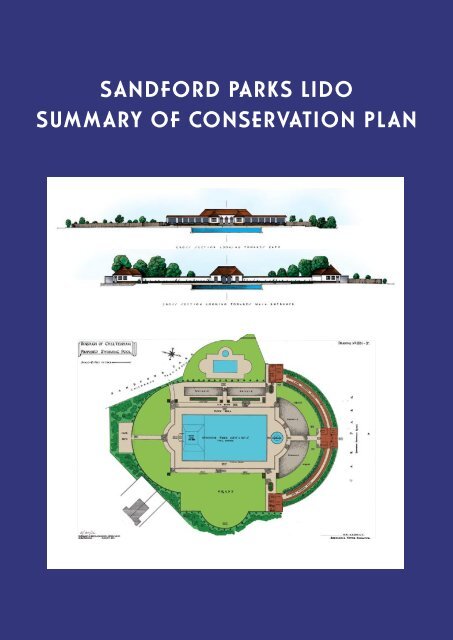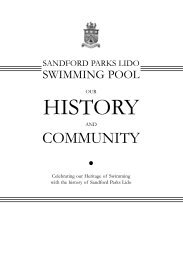Lido Conservation Summary.pdf - Sandford Parks Lido
Lido Conservation Summary.pdf - Sandford Parks Lido
Lido Conservation Summary.pdf - Sandford Parks Lido
You also want an ePaper? Increase the reach of your titles
YUMPU automatically turns print PDFs into web optimized ePapers that Google loves.
S AND F ORD PA R K S L I D O<br />
S U M M ARY O F CO N S E R VAT I O N P L AN
OUR CONSERVATION M ANAGE MENT PL AN<br />
As part of its application to the Heritage Lottery<br />
Fund, which secured the funding for the restoration<br />
of the main pool and its surrounding areas, <strong>Sandford</strong><br />
<strong>Parks</strong> <strong>Lido</strong> stated that it will commission and sign<br />
up to a <strong>Conservation</strong> Management Plan, which will<br />
help us identify and protect the important aspects of<br />
this wonderful site for the future. The author of this<br />
document is Jeremy Lake, who has over 25 years of<br />
experience in historic buildings and conservation, and<br />
has worked for English Heritage since 1988. It includes<br />
detailed policies and guidance for the maintenance<br />
and enhancement of this nationally important site. It<br />
also brings together the results of new research into<br />
the history of the lido and its place in the development<br />
of open-air swimming pools, recreation and designed<br />
landscapes.<br />
Consultation<br />
This summary is aimed at the local community and<br />
those who use and enjoy the lido. It is divided into:<br />
1. A statement of significance, which sets out the<br />
importance of the site.<br />
2. A summary of key values, focused on the site itself<br />
and the benefits it affords to the community, as a<br />
place of recreation, shared memories as well as in<br />
terms of education and the broader economy.<br />
Our Community – What makes the lido a special place<br />
for you?<br />
The <strong>Conservation</strong> Plan has revealed many dimensions to<br />
the lido and its history, which we believe are important<br />
to identify. In particular, therefore, we would welcome<br />
your thoughts on why the lido is a special place for you.<br />
There are a number of factors that you may consider<br />
important, ranging from its historic importance, the<br />
character and beauty of the whole site, or its value<br />
as a place for recreation, sport, the local community,<br />
education or the local economy. It does not matter if<br />
there is an aspect that does not fit within these headings.<br />
We just want to know what you think is important.<br />
The deadline for the delivery of comments, after which<br />
the final plan will be revised and published, is the 22nd<br />
of June 2008.<br />
We would welcome your views, which can be e-mailed<br />
to swim@sandfordparkslido.org.uk handed over at the<br />
ticket office or posted to us at:<br />
<strong>Conservation</strong> Plan<br />
<strong>Sandford</strong> <strong>Parks</strong> <strong>Lido</strong><br />
Keynsham Road<br />
Cheltenham<br />
Glos<br />
GL53 7PU<br />
3. Policies for conservation, enhancement and<br />
education.<br />
The full version of this plan, with many plans, photographs<br />
and drawings, can be found on the <strong>Sandford</strong> <strong>Parks</strong> <strong>Lido</strong><br />
website at www.sandfordparkslido.org.uk.<br />
1
STAT E M E NT O F SIGNIFIC ANCE<br />
<strong>Sandford</strong> <strong>Parks</strong> <strong>Lido</strong> (www.sandfordparkslido.org.uk),<br />
which was opened in 1935, is a nationally important<br />
example of a lido. <strong>Lido</strong>s were open-air swimming<br />
and recreational landscapes that developed across<br />
Europe in the 1920s and 1930s. Their landscaping and<br />
architecture spoke at the national level of the need to<br />
improve health, the cult of sun worship that marked<br />
Western culture in this period and the development of<br />
recreation as a less segregated and more inclusive form<br />
of cultural activity. At the local level they spoke of the<br />
spirit of municipal competition and the desire to foster<br />
a new type of place, which was clean, pleasant and<br />
convivial, for the enjoyment of this new form of cultural<br />
activity. Out of 98 surviving lidos in England, Wales and<br />
Scotland, <strong>Sandford</strong> <strong>Parks</strong> <strong>Lido</strong> represents better than<br />
any other lido how the planning of lidos presented<br />
opportunities to link buildings to landscape and open<br />
space, and thus harness the regenerative qualities of air<br />
and sunlight.<br />
Taken as a whole, <strong>Sandford</strong> <strong>Parks</strong> <strong>Lido</strong> is an outstanding<br />
example of 20th century outdoor architecture, its design<br />
being based on an integrated approach to its three<br />
key elements – water, landscaping and architecture.<br />
The whole site expresses the historic function and<br />
importance of lidos, and their distinctive quality as<br />
places created in the inter-war period, through its<br />
setting, planning, landscape and design. It was built to<br />
the designs of the Borough Engineer, G. Gould Marsland,<br />
with the advice of the noted landscape architect<br />
and horticulturalist Edward White. White held the<br />
presidency of the newly-formed Landscape Architects<br />
Association between 1931 and 1933, and as part of<br />
the nationally renowned Milner White & Partners had<br />
designed gardens for public parks and private houses.<br />
This collaboration explains much about the character of<br />
the lido, and in particular how it links to the adjoining<br />
park and the influence of Arts and Crafts garden design<br />
in its overall planning and the use of features such as<br />
yew hedges and drystone walling. This style – which<br />
was very influential on an international basis and<br />
became strongly associated with the Cotswolds region<br />
- was based on the idea of a return to traditional craft<br />
skills and good building materials. At <strong>Sandford</strong> <strong>Parks</strong><br />
<strong>Lido</strong> it is expressed in the combination of the geometric<br />
layout and the use of picturesque planting to provide<br />
varied colour, form and shape. The needs for relaxation,<br />
other forms of activity than swimming, and sun worship<br />
are met in the integration of open lawned areas and<br />
sun decks into the overall planning of the site. The<br />
importance of refreshment is displayed in the café and<br />
terraces, the former also being linked to <strong>Sandford</strong> Park<br />
through the café garden and park cafe. The terraces<br />
provided an additional vantage point, looking across<br />
the pool, for relaxation and contemplation.<br />
It is significant that the lido was developed within<br />
Cheltenham, which is internationally renowned as a<br />
spa town. Its villas and terraces had developed around a<br />
series of spas dispersed around the town, and municipal<br />
parks emerged as a fundamental aspect of the 19th<br />
century town. <strong>Parks</strong>, including in this case <strong>Sandford</strong><br />
Park which it adjoins, continued to play a key part in the<br />
20th century expansion of Cheltenham. The lido was<br />
sited on the eastern edge of the 19th century town, and<br />
provision for car parking was considered at the outset<br />
to be fundamental to its viability and future.<br />
<strong>Sandford</strong> <strong>Parks</strong> <strong>Lido</strong> is also a unique survival of industrial<br />
archaeological importance. This is because the 1930s<br />
engineering of the site, which was aimed at ensuring<br />
water quality and purity, has survived complete. All<br />
visitors to the site are greeted by the sight and sound<br />
of the fountain, which is placed on the main design axis<br />
of the site, but few are aware of the complex system of<br />
underground pipes that linked the pools to the filtration<br />
and heating plant which are sited in a building outside<br />
the pool area.<br />
VALUES<br />
Change can undermine or enhance the character and<br />
special qualities of this place, and must be informed<br />
by an understanding of the values invested in it. To its<br />
distinctive design, and importance within this national<br />
context, must be added the special sense of place<br />
afforded to visitors by its light, sounds and colour.<br />
Set out below are a series of key values, which lido users<br />
and the public have and will be asked to contribute to.<br />
These have been divided into two categories of:<br />
• A) what makes the lido significant in its broader<br />
architectural and historic context and<br />
• B) the benefits it affords to the community, as<br />
a place of recreation, shared memories as<br />
well as in terms of education and the broader<br />
economy.<br />
A1<br />
Historic Value<br />
<strong>Sandford</strong> <strong>Parks</strong> <strong>Lido</strong> is one of the best preserved lidos in<br />
Britain. The lido also reflects important developments<br />
in 20th century society, and in particular the growing<br />
importance of leisure and more informal approaches<br />
towards it.<br />
2
A cross-section of the site, showing the pool and planting.<br />
A2<br />
Aesthetic and Monumental Value<br />
<strong>Sandford</strong> <strong>Parks</strong> <strong>Lido</strong> was designed as a place where the<br />
pool, buildings, walls and landscape were all designed<br />
from the outset as an integrated whole. This, and in<br />
particular the Arts and Crafts approach to its overall<br />
planning and landscaping, is a key element of the site’s<br />
significance in a British and European context. The<br />
beauty of the setting, the mix of architectural styles<br />
and planning, and the unique technical importance<br />
afforded by the survival of the plant room interior, all<br />
add to this significance.<br />
B1<br />
Community and Recreational Value<br />
The lido is a safe and wonderful environment in which<br />
children and adults can play, socialise, keep fit, relax,<br />
learn new skills, have fun and gain a sense of physical<br />
and emotional well-being. It is a perfect venue for<br />
community recreation, and its development as a concept<br />
in parallel with the enhanced role of communities in<br />
national government and the planning system.<br />
B2<br />
Educational Value<br />
The site itself, and its broader historical meaning and<br />
significance, can be interpreted to the public through<br />
the lido website and through images. The lido can serve<br />
as a focus for life-long learning and the exchange of<br />
experiences between generations. It can also serve as<br />
an arena for the arts, and for children to learn about<br />
and contribute to our understanding of ‘place’ through<br />
its landscape and buildings.<br />
3<br />
B3<br />
Economic Value<br />
The lido is one of a series of key venues that contribute<br />
to tourism and the prosperity of Cheltenham. The<br />
lido is one of a series of key venues that contribute to<br />
tourism and the prosperity of Cheltenham. It is the only<br />
outdoor facility 50-metre pool in Britain which has been<br />
inspected and meets the international standards for<br />
competition swimming set by the Amateur Swimming<br />
Association.<br />
POLICIES<br />
Whole Site Policy and Guidance for Sustainable<br />
Development<br />
The key aim is to maintain and enhance the character<br />
and special significance of the lido as a whole.<br />
CONSERVATION POLIC Y<br />
1. Ensure that future improvement to the buildings,<br />
and reinstatement of lost features, enhances the<br />
special character of <strong>Sandford</strong> <strong>Parks</strong> <strong>Lido</strong>, through:<br />
• Ensuring that annual maintenance of walls and<br />
buildings is built into the <strong>Lido</strong> Business Plan.<br />
• Ensuring ‘like-for-like’ repair of walls, building<br />
materials and features.<br />
• Ensuring that the maintenance of it landscape<br />
and planting retains the original design<br />
concept, in terms of the gradation of colour and<br />
form, and ensures ‘like-for-like’ replacement of<br />
yew hedge and poplar.
An aerial view of the lido in 1947, showing the overall geometric<br />
plan of the site and its surrounding area, including the car park and<br />
<strong>Sandford</strong> Park.<br />
Panorama looking south west, showing the planting framing the lido.<br />
2. Build the views of the public and lido users into<br />
future revisions of the Values Statement and<br />
Management Plan.<br />
Continuing consultation and evaluation will, after<br />
its adoption, inform revisions to the <strong>Conservation</strong><br />
Management Plan on a 5-yearly basis.<br />
E D U C ATIONAL POLIC Y<br />
3. Communicate the lido’s heritage, especially among<br />
children and young people, in order to raise<br />
awareness of its value and the benefits that it<br />
provides, through:<br />
• Exhibition boards<br />
• Use of the café as a ‘portal’ – both the park<br />
entrance and the main café<br />
• An interactive Living Archive, based at the lido<br />
and on-line, will capture the memories and<br />
perceptions of its visitors, particularly children.<br />
4












